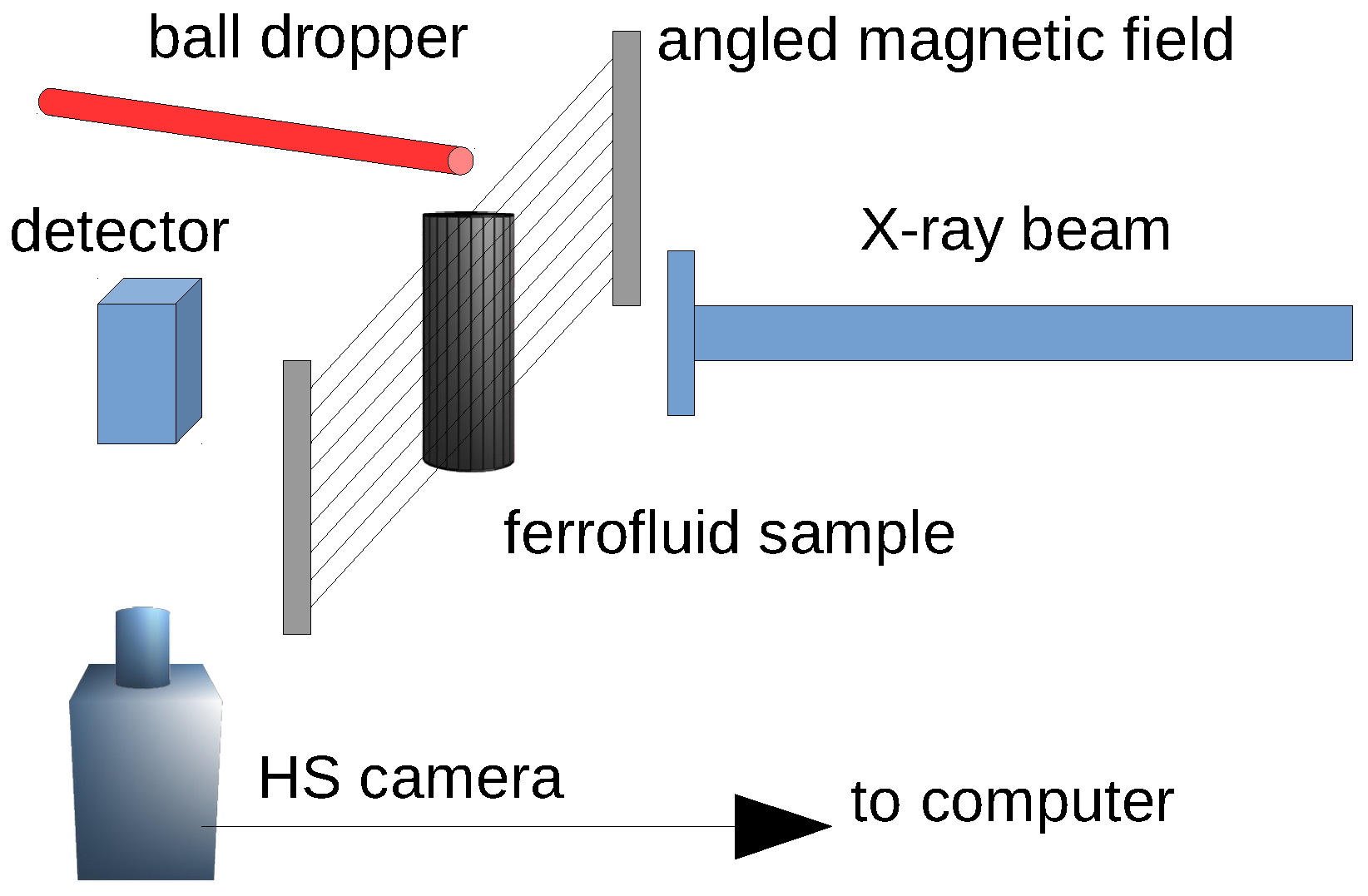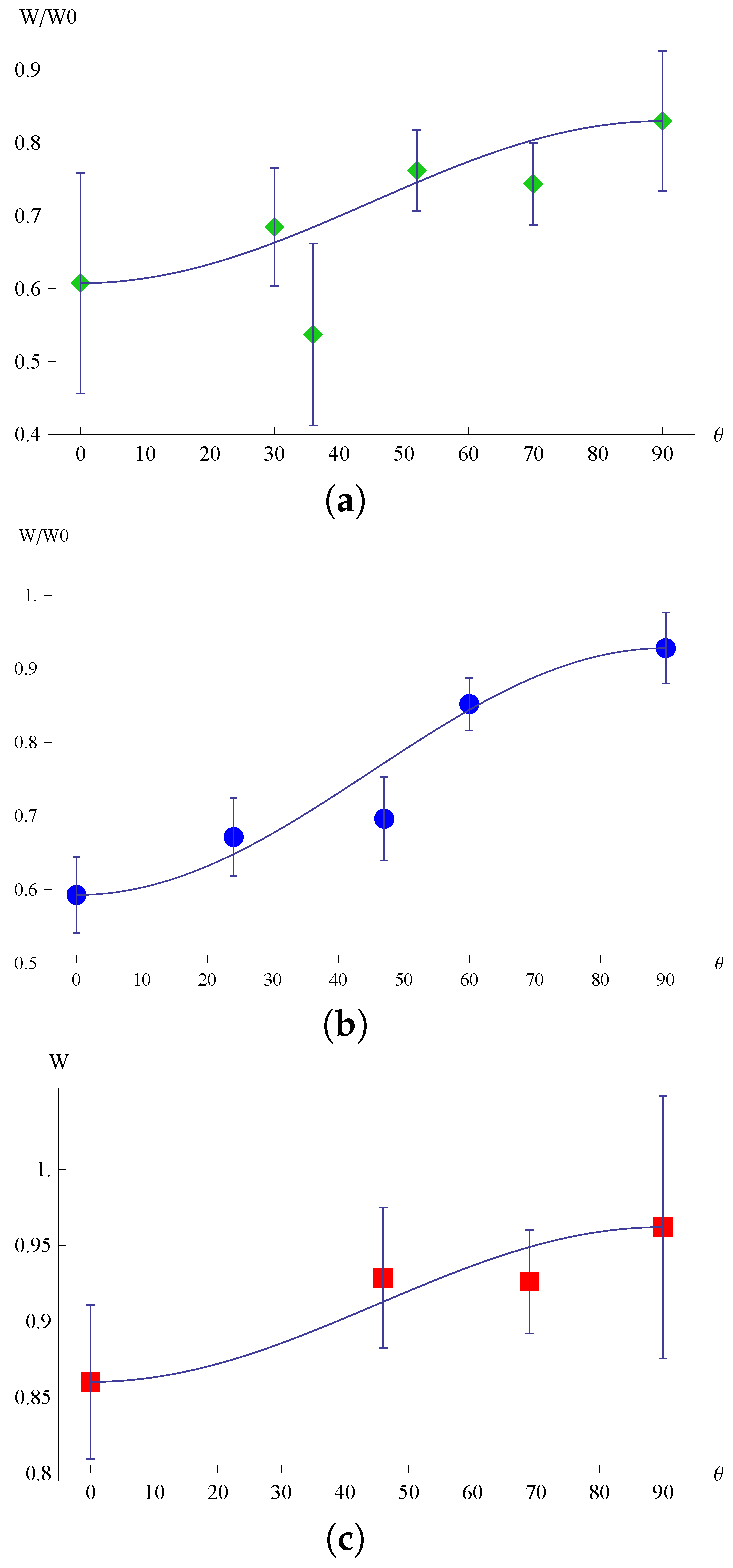Flow Anisotropy due to Thread-Like Nanoparticle Agglomerations in Dilute Ferrofluids
Abstract
:1. Introduction
2. Materials and Methods
2.1. Overview
2.2. Derivation of Model Predictions
2.3. Experiment
3. Results
4. Discussion
5. Conclusions
Acknowledgments
Author Contributions
Conflicts of Interest
References
- Rinaldi, C.; Chaves, A.; Elborai, S.; He, X.; Zahn, M. Magnetic fluid rheology and flows. Curr. Opin. Colloid Interface Sci. 2005, 10, 141–157. [Google Scholar] [CrossRef]
- Torres-Diaz, I.; Rinaldi, C. Recent progress in ferrofluids research: Novel applications of magnetically controllable and tunable fluids. Soft Matter 2014, 10, 8584–8602. [Google Scholar] [CrossRef] [PubMed]
- Odenbach, S. (Ed.) Ferrofluids: Magnetically Controllable Fluids and Their Applications; Lecture Notes in Physics; Springer: Berlin/Heidelberg, Germany, 2002; Volume 594. [Google Scholar]
- Raj, K.; Hirota, Y.; Black, T. Current and emerging applications of ferrofluids. Magnetohydrodynamics 2013, 49, 568–581. [Google Scholar]
- Trahms, L. Biomedical Applications of Magnetic Nanoparticles. In Colloidal Magnetic Fluids: Basics, Development and Application of Ferrofluids; Lecture Notes in Physics; Odenbach, S., Ed.; Springer: Berlin/Heidelberg, Germany, 2009; Volume 763, pp. 327–358. [Google Scholar]
- Nowak, J.; Wolf, D.; Odenbach, S. A rheological and microscopical characterization of biocompatible ferrofluids. J. Magn. Magn. Mater. 2014, 354, 98–104. [Google Scholar] [CrossRef]
- Jeyadevan, B.; Torigoe, T.; Nakatsuka, K.; Nakatani, I.; Fujita, T.; Oka, H. X-ray image analysis and ultramicroscope study of magnetic fluids used as working liquid in heat transfer experiments. J. Appl. Phys. 1999, 85, 5968–5970. [Google Scholar] [CrossRef]
- Nakatsuka, K.; Jeyadevan, B.; Akagami, Y.; Torigoe, T.; Asari, S. Visual observation of the effect of magnetic field on moving air and vapor bubbles in a magnetic fluid. J. Magn. Magn. Mater. 1999, 201, 256–259. [Google Scholar] [CrossRef]
- Lee, W.; Scardovelli, R.; Trubatch, A.; Yecko, P. Numerical, experimental, and theoretical investigation of bubble aggregation and deformation in magnetic fluids. Phys. Rev. E 2010, 81, 016302. [Google Scholar] [CrossRef] [PubMed]
- Yecko, P.; Lee, W.K.; Trubatch, A.D.; Vieira, M. Drag enhancement due to macro-chains in uniformly magnetized ferrofluids. J. Magn. Magn. Mater. 2011, 323, 1288–1292. [Google Scholar] [CrossRef]
- Hayes, C.F. Observation of association in a ferromagnetic colloid. J. Colloid Interface Sci. 1975, 52, 239–243. [Google Scholar] [CrossRef]
- Horng, H.E.; Hong, C.Y.; Yang, S.Y.; Yang, H.C. Novel properties and applications in magnetic fluids. J. Phys. Chem. Sol. 2001, 62, 1749–1764. [Google Scholar] [CrossRef]
- Jones, G.A. Aggregation of water-based magnetic liquids observed with the polarizing microscope. J. Phys. D-Appl. Phys. 1985, 18, 1281–1290. [Google Scholar] [CrossRef]
- Taketomi, S.; Takahashi, H.; Inaba, N.; Miyajima, H. Experimental and theoretical investigations on agglomeration of magnetic colloidal particles in magnetic fluids. J. Phys. Soc. Jpn. 1991, 60, 1689–1707. [Google Scholar] [CrossRef]
- Isimoto, J.; Okubo, M.; Higashitani, S.K.M. Bubble behavior in magnetic fluid under a nonuniform magnetic field. JSME Int. J. B Fluids Therm. Eng. 1995, 38, 382–387. [Google Scholar] [CrossRef]
- Bashtovoi, V.; Kovalev, M.; Reks, A. Instabilities of bubbles and droplets flows in magnetic fluids. J. Magn. Magn. Mater. 2005, 289, 350–352. [Google Scholar] [CrossRef]
- Drenckhan, W.; Elias, F.; Hutzler, S.; Weaire, D.; Janiaud, E.; Bacri, J.C. Bubble size control and measurement in the generation of ferrofluid foams. J. Appl. Phys. 2003, 93, 10078–10083. [Google Scholar] [CrossRef]
- Wang, Z.; Holm, C.; Muller, H.W. Boundary condition effects in the simulation study of equilibrium properties of magnetic dipolar fluids. J. Chem. Phys. 2003, 119, 379–387. [Google Scholar] [CrossRef]
- Wiedenmann, A.; Heinemann, A. Field-induced ordering phenomena in ferrofluids observed by small-angle neutron scattering. J. Magn. Magn. Mater. 2005, 289, 58–61. [Google Scholar] [CrossRef]
- Krueger, D. Review of agglomeration in ferrofluids. IEEE Trans. Magn. 1980, 16, 251–253. [Google Scholar] [CrossRef]
- Butter, K.; Bomans, P.; Frederik, P.; Vroege, G.; Philipse, A. Direct observation of dipolar chains in iron ferrofluids by cryogenic electron microscopy. Nat. Mater. 2003, 2, 88–91. [Google Scholar] [CrossRef] [PubMed]
- Bacri, J.C.; Salin, D. Optical scattering on ferrofluid agglomerates. J. Phys. Lett. 1982, 34, 771–777. [Google Scholar] [CrossRef]
- Klokkenburg, M.; Erné, B.H.; Meeldijk, J.D.; Wiedenmann, A.; Petukhov, A.V.; Dullens, R.P.A.; Philipse, A.P. In situ imaging of field-induced hexagonal columns in magnetite ferrofluids. Phys. Rev. Lett. 2006, 97, 185702. [Google Scholar] [CrossRef] [PubMed]
- Andelman, D.; Rosensweig, R.E. The Phenomenology of Modulated Phases: From Magnetic Solids and Fluids to Organic Films and Polymers. In Polymers, Liquids and Colloids in Electric Fields: Interfacial Instabilities, Orientation and Phase Transitions; Tsori, Y., Steiner, U., Eds.; Soft Condensed Matter; World Scientific: Singapore, 2009; Volume 2, pp. 1–56. [Google Scholar]
- Lee, W.K. X-ray microtomography of field-induced macro-structures in a ferrofluid. J. Magn. Magn. Mater. 2010, 322, 2525–2528. [Google Scholar] [CrossRef]
- Sano, K.; Doi, M. Theory of agglomeration of ferromagnetic particles in magnetic fluids. J. Phys. Soc. Jpn. 1983, 52, 2810–2815. [Google Scholar] [CrossRef]
- Zubarev, A.Y.; Iskakova, L.Y. To the theory of rheological properties of ferrofluids: Influence of drop-like aggregates. Phys. A Stat. Mech. Appl. 2004, 343, 65–80. [Google Scholar] [CrossRef]
- Odenbach, S.; Raj, K. The influence of large particles and agglomerates on the magnetoviscous effect in ferrofluids. Magnetohydrodynamics 2000, 36, 312–319. [Google Scholar] [CrossRef]
- Thurm, S.; Odenbach, S. Particle size distribution as key parameter for the flow behavior of ferrofluids. Phys. Fluids 2003, 15, 1658–1664. [Google Scholar] [CrossRef]
- Lee, W.K.; Ilavsky, J. Particle size distribution in ferrofluid macro-clusters. J. Magn. Magn. Mater. 2013, 330, 31–36. [Google Scholar] [CrossRef]
- Santiago-Quinones, D.I.; Raj, K.; Rinaldi, C. A comparison of the magnetorheology of two ferrofluids with different magnetic field-dependent chaining behavior. Rheol. Acta 2013, 52, 719–726. [Google Scholar] [CrossRef]
- Chantrell, R.; Sidhu, J.; Bissell, P.; Bates, P. Dilution induced instability in ferrofluids. J. Appl. Phys. 1982, 53, 8341–8343. [Google Scholar] [CrossRef]
- Gerth-Noritzsch, M.; Borin, D.Y.; Odenbach, S. Anisotropy of the magnetoviscous effect in ferrofluids containing nanoparticles exhibiting magnetic dipole interaction. J. Phys. Condens. Matter 2011, 23, 346002. [Google Scholar] [CrossRef] [PubMed]
- Mertelj, A.; Resetic, A.; Gyergyek, S.; Makovec, D.; Copic, M. Anisotropic microrheological properties of chain-forming magnetic fluids. Soft Matter 2011, 7, 125–131. [Google Scholar] [CrossRef]
- Ghosh, S.; Puri, I.K. Soft polymer magnetic nanocomposites: Microstructure patterning by magnetophoretic transport and self-assembly. Soft Matter 2013, 9, 2024–2029. [Google Scholar] [CrossRef] [PubMed]
- Rosensweig, R.E.; Keiser, R.; Miskolczy, G. Viscosity of magnetic fluid in a magnetic field. J. Colloid Interface Sci. 1969, 29, 680–686. [Google Scholar] [CrossRef]
- Shliomis, M.I. Effective viscosity of magnetic suspensions. Sov. Phys. JETP 1972, 34, 1291–1294. [Google Scholar]
- Rosensweig, R.E. Ferrohydrodynamics; Cambridge University Press (Dover): New York, NY, USA, 1984 (1997).
- De Gennes, P.G.; Pincus, P.A. Pair correlations in a ferromagnetic colloid. Z. Phys. B Condens. Matter 1970, 11, 189–198. [Google Scholar] [CrossRef]
- Rosensweig, R. Towards ferrofluids with enhanced magnetization. J. Magn. Magn. Mater. 2011, 323, 1191–1197. [Google Scholar] [CrossRef]
- McTague, J.P. Magnetoviscosity of magnetic colloids. J. Chem. Phys. 1969, 51, 133–136. [Google Scholar] [CrossRef]
- Kamiyama, S.; Satoh, A. Rheological properties of magnetic fluids with the formation of clusters: Analysis of simple shear flow in a strong magnetic field. J. Colloid Interface Sci. 1989, 127, 173–188. [Google Scholar] [CrossRef]
- Felicia, L.; Vinod, S.; Philip, J. Recent advances in magnetorheology of ferrofluids (magnetic nanofluids)—A critical review. J. Nanofluids 2016, 5, 1–22. [Google Scholar] [CrossRef]
- Cunha, F.R.; Rosa, A.P.; Dias, N.J. Rheology of a very dilute magnetic suspension with micro-structures of nanoparticles. J. Magn. Magn. Mater. 2016, 397, 266–274. [Google Scholar] [CrossRef]
- Linke, J.; Odenbach, S. Anisotropy of the magnetoviscous effect in a ferrofluid with weakly interacting magnetic nanoparticles. J. Phys. Condens. Matter 2015, 27, 176001. [Google Scholar] [CrossRef] [PubMed]
- Dohmen, E.; Borin, D.; Zubarev, A. Magnetic field angle dependent hysteresis of a magnetorheological suspension. J. Magn. Magn. Mater. 2017, 443, 275–280. [Google Scholar] [CrossRef]
- Batchelor, G.K. Slender-body theory for particles of arbitrary cross-section in Stokes flow. J. Fluid Mech. 1970, 44, 419–440. [Google Scholar] [CrossRef]
- Lauga, E.; Powers, T.R. The hydrodynamics of swimming microorganisms. Rep. Prog. Phys. 2009, 72, 096601. [Google Scholar] [CrossRef]
- Franklin, T.A. Ferrofluid Flow Phenomena. Ph.D. Thesis, Massachusetts Institute of Technology, Cambridge, MA, USA, June 2003. [Google Scholar]
- Cali, A. Magnetoviscous Effects of Magnetized Particle Threads in Magnetized Ferrofluids. Master’s Thesis, Montclair State University, Montclair, NJ, USA, 2014. [Google Scholar]



| Configuration | ||
|---|---|---|
| EFH-1 with B magnet | 0.76 | 0.58 |
| EFH-1 with C magnet | 0 .47 | 1.31 |
| P2XD with C magnet | 0.92 | 0.13 |
© 2017 by the authors. Licensee MDPI, Basel, Switzerland. This article is an open access article distributed under the terms and conditions of the Creative Commons Attribution (CC BY) license (http://creativecommons.org/licenses/by/4.0/).
Share and Cite
Cali, A.; Lee, W.-K.; Trubatch, A.D.; Yecko, P. Flow Anisotropy due to Thread-Like Nanoparticle Agglomerations in Dilute Ferrofluids. Fluids 2017, 2, 67. https://doi.org/10.3390/fluids2040067
Cali A, Lee W-K, Trubatch AD, Yecko P. Flow Anisotropy due to Thread-Like Nanoparticle Agglomerations in Dilute Ferrofluids. Fluids. 2017; 2(4):67. https://doi.org/10.3390/fluids2040067
Chicago/Turabian StyleCali, Alexander, Wah-Keat Lee, A. David Trubatch, and Philip Yecko. 2017. "Flow Anisotropy due to Thread-Like Nanoparticle Agglomerations in Dilute Ferrofluids" Fluids 2, no. 4: 67. https://doi.org/10.3390/fluids2040067




